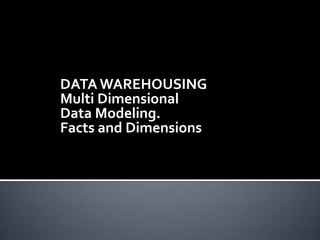
Dw design 1_dim_facts
- 1. DATA WAREHOUSING Multi Dimensional Data Modeling. Facts and Dimensions
- 2. 2
- 3. While an entity-relationship modeling approach from relational database design could be used, the dimensional modeling approach to logical design is more often used for a data warehouse. 3
- 4. End users cannot understand, remember, navigate an E/R model (not even with a GUI) One reason is that an enterprise- level ERM would be too complex to understand. 4
- 5. Software cannot usefully query an E/R model 5
- 6. Use of E/R modeling doesn’t meet the DW purpose: intuitive and high performance querying 6
- 7. Employee_Dim EmployeeKey EmployeeID . . . Dimension Table Time_Dim Fact Table Product_Dim TimeKey Sales_Fact ProductKey TheDate TimeKey ProductID . . . EmployeeKey . . ProductKey . CustomerKey ShipperKey $ . . . Shipper_Dim Customer_Dim ShipperKey CustomerKey ShipperID CustomerID . . . . . . 7
- 8. Several distinct dimensions, combined with facts, enable you to answer business Dimension questions. Tables Geographic Dimension Measures Fact Table Geographic Product Time Units $ Product Facts Time 8
- 9. Dimensions They are normally textual and descriptive descriptions of the business. 9
- 10. Dimensions dimension tables contain relatively small amounts of relatively static data 10
- 11. Dimensions dimension table: usually not- normalized 11
- 12. Dimensions Independent of each other, not hierarchically related 12
- 13. Dimensional attributes (attributes no key) help to describe the dimensional value. Dimensional attributes 13
- 14. Facts Fact are (usually numerical) measures of business. 14
- 15. Facts Fact table is the largest table in the star schema and is composed of large volumes of data 15
- 16. Facts Fact table is (often) normalized 16
- 17. Facts fact table has a composite primary key made up of foreign keys PK = FKi 17
- 18. Facts fact table usually contains one or more numerical facts that occur for the combination of keys that define each record measures 18
- 19. Facts A fact table contains either detail-level facts or facts that have been aggregated (summary tables) Σ 19
- 20. Facts Facts are: additive semi-additive non-additive 20
- 21. Facts Non-additive facts cannot be added at all. An example of this is averages. Semi-additive facts can be aggregated along some of the dimensions and not along others: current_Balance is a semi-additive fact as it makes sense to add them up for all accounts (what's the total current balance for all accounts in the bank?) but it does not make sense to add them up through time (adding up all current balances for a given account for each day of the month does not give us any useful information The most useful measures are: Numeric, Additive 21
- 22. Atomic level of data of the business process A definition of the highest level of detail that is supported in a data warehouse 22
- 23. A fact table usually contains facts with the same level of aggregation a proper dimensional design allows only facts of a uniform grain (the same dimensionality) to coexist in a single fact table 23
- 24. Some perfectly good fact tables represent measurements that have no facts! This kind of measurements is often called an event. The classic example of such a factless fact table is a record representing a student attending a class on a specific day. The dimensions are Day, Student, Professor, Course, and Location, but there are no obvious numeric facts. The tuition paid and grade received are good facts but not at the grain of the daily attendance. 24
- 25. Dimensions without attributes. (Such as a transaction number or order number.) Put the attribute value into the fact table even though it is not an additive fact. 25
- 26. 26
- 27. Employee_Dim EmployeeKey EmployeeID Fact table provides statistics . . for sales broken down by . product, time, employee, shipper and customer, dimensions Time_Dim Product_Dim TimeKey Sales_Fact ProductKey TheDate TimeKey TimeKey ProductID . . . EmployeeKey . . Dimensional Keys ProductKey . Multipart Key CustomerKey ShipperKey $ . Measures . . Shipper_Dim Customer_Dim ShipperKey CustomerKey ShipperID CustomerID . . . . . . 27
- 28. 28
- 29. 1. Choosing the data mart for the small group of end users we deal with. Choose a business process to model, e.g., orders, invoices, etc. 29
- 30. 2. Fact table granularity (the smallest defined level of data in the table) is determined. 30
- 31. 3. Fact table dimensions are selected. Choose the dimensions that will apply to each fact table record Add dimensions for "everything you know" about this grain. 31
- 32. 4. Determine the facts for the table. In most cases, the granularity is at the transaction level, so the fact is the amount. Choose the measure that will populate each fact table record Add numeric measured facts true to the grain 32
- 33. The Data Warehouse Toolkit.Second Edition.The Complete Guide to Dimensional Modeling.Ralph Kimball.Margy Ross
